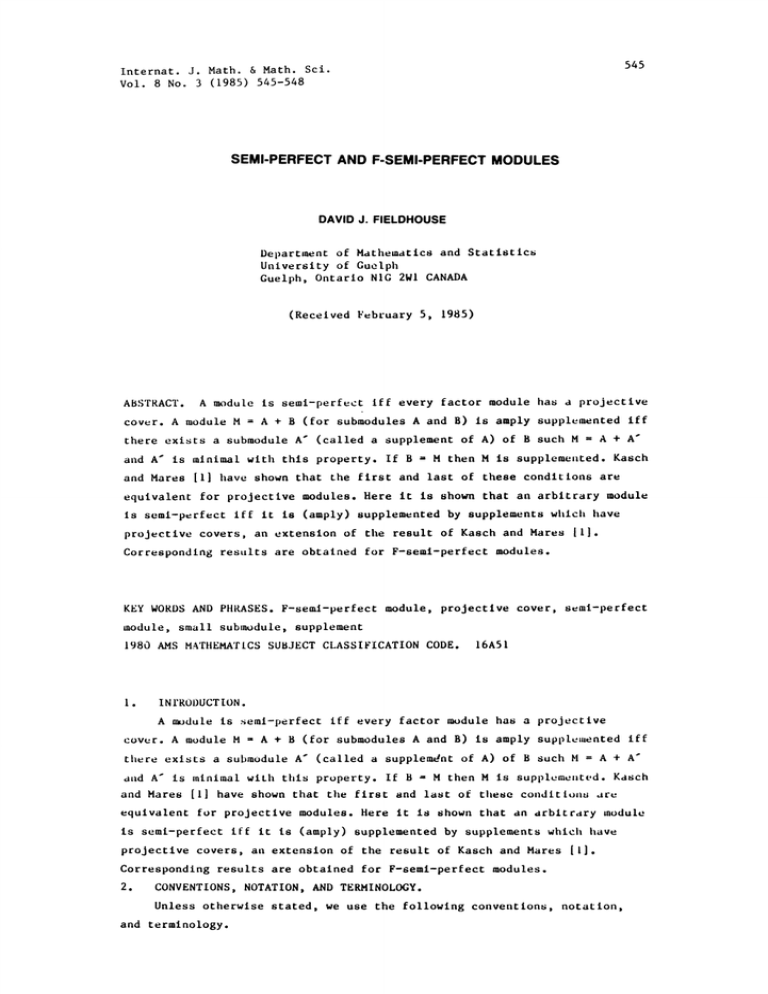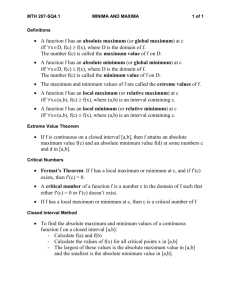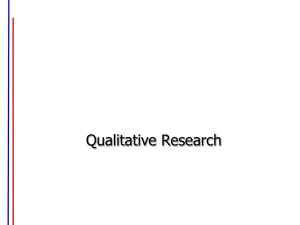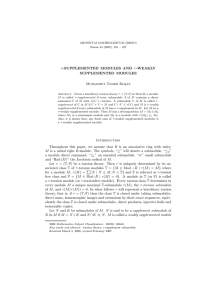SEMI-PERFECT AND F-SEMI-PERFECT MODULES 545-548 DAVID
advertisement

545 Internat. J. Math. & Math. Sci. Vol. 8 No. 3 (1985) 545-548 SEMI-PERFECT AND F-SEMI-PERFECT MODULES DAVID J. FIELDHOUSE Department of Mathematics and Statlsticn University of Guelph Guelph, Ontario NIG 2WI CANADA (Received February 5, 1985) ABSTRACT. A module is seml-perfect Iff every factor module has a projective cover. A module M A + B (for submodules A and B) Is amply supplemented A" (called a supplement of A) of B such M A + there exists a submodule and A" is minimal with this property. If B and Mares M then M is supplemented. Kasch [I] have shown that the first and last of these conditions are equivalent for projective modules. Here It Is shown that an arbitrary module is seml-perfect Iff it is (amply) supplemented by supplements which have projective covers, an extension of the result of Kasch and Mares [I]. Corresponding results are obtained for F-seml-perfect modules. KEY WORDS AND PIIRASES. F-seml-perfect module, projective cover, seml-perfect module, small subtaodule, supplement 1980 AMS MATIIEMAT[CS SUBJECT CLASSIFICATION CODE. 1. 16A51 INTRODUCTION. A dule is seml-perfect iff every factor module has a projective cover. A module M A / B (for submodules A and B) Is amply suppleaented iff there exists a submodule A" A" (called a supplemdnt of A) of B such M A + A" M then M is supplemented. Kasch and Mares [1] have shown that the first and last of these condition,s are and is minimal with this property. If B equivalent for projective modules. Here it is shown that an arbitrary ,nodule is seml-perfect iff it is (amply) supplemented by supplements which have projective coers, an extension of the result of Kasch and Mares [l]. Correspondlng results are obtained for F-seml-perfect modules. 2. CONVENTIONS, NOTATION, AND TERMINOLOGY. Unless otherwise stated, we use the following conventlon, notation, and terminology. 546 D.J. FIELDHOUSE All rings are associative, but not necessarily commutative. Every rlng has a multipllcatlve Identlty element, denoted by I, which Is preserved by rlng homomorphlsms, Inherlted by subrlngs, and acts as the Identlty operator on modules. We use the word map for module homomorphism. Maps are written on the side opposite to that of the scalars. Thus the order of wrltlug map compositions depends on the side of the module. If M and N are R-modules we usually write Hom(M,N) for llomK(M,N) wlen no confusion can arise. The symbols < and > will be used to denote proper set theoretlcal Incluslon and containment, respectively, as well as the usual order relationships. The symbols and ), respectively, are used for the preceedlng if equality can occur. A submodule S of a module M Is defined to be small (or super[luous) iff whenever S + M M for a submodule M of M then we must have M M. A map with a small kernel is called a small map. It is easy to verify that the product of small surJectlve maps is small and that small submodules are small in overmodules. A module M covers or is a cover of a module N iff there is a small eplmorphism from M to N. If M is projective it is called a projective cover. Basic properties of projective covers can be found in Bass [21 and Kasch [3]. Following Kasch [3] we call a module semi-perfect Iff every factor module has a projective cover. Kasch [3] contains basle facts about semi- perfect modules. The following Lemma and its Corollary are easy to verify: Y & Z are modules then: LEMMA. If X Y is small in Z iff X is small in Z and Y/X Is small in Z/X. COROLLARY. Z covers Z/Y iff Z covers Z/X and Z/X covers Z/Y. SUPPLEMENTS. 3. Let A, B, A" be submodules of a module M The submodule A" is called a supplement in B of the submodule A iff A B, M A + A’, and A" is minimal with respect to ti lat property. If B M we say that A is a supplement of A. is contaied in We now have: PROPOSiTiON I. The submodule A is a supplement in B of tile submodule A Iff: () M A + A e. (2) The utersectlon of A ad A (3) A is a submodule of B. is a small submodule of A e. PROOF. The "only if" part can be found in Kasch [3]. The "if" part is an easy modification of the preceedlng. COROLLARY. The submodule A A + A . is a supplement of the submodule A iff M and the lutersectlon of A and A is small n A SEMI-PERFECT AND F-SEMI-PERFECT MODULES 4. 547 (AMPLY) SUPPLEMENTED MODULES. A module is defined to be supplemented iff every submodule has a supplement. The module M is defined to be amply supplemented Iff M A + B implies that A has a supplement in B. PROPOSITION 2. Let X be a submodule of the module Y, and let Hom(Y,Y/X) be the canonical eplmorphism. Also let P be any module, element of Hom(P,Y/X) and g an element of an Hom(P,Y) such that f Is g composed with h. [f lm denotes image, then: (1) The ma[ f is an eplmorphism lff Y X + Ira(g). (2) X ia small In Y iff f being an eplmorphism fh equivalent’ to g beig an eplmorphlsm for all such f,g, and P. (3) The p Is a sll eplmorphlsm Iff Ira(g) Is a supplement of X dad g a small map. (4) If X is small n Y then: f Is a small eplmorphlsm Iff g is a eplmophlsm. PROOF. (1) and tle "If" part of (2) are easy. For he "only If" par of (2), If Y X + Z for some sub,nodule Z of Y hen he Inclusion map g from Z o Y/X Is an eplmorlhlsm. (3) If f iu a small eplmorphlsm then he image of Its kernel under g, which Is ie IntcrsecEioa of lm(g) with X, is small in Ira(g). This Implies thaI Ira(g) is a upplem:n of X since f is an eplmorphlsm. Moreover the kernel of an eplmorphlsm since the canonical p f from Z g s be small since Is contained In he kernel of f. Conversely, The smallness of boh he kernel of g and he Intersection of Ira(g) wih X implies the smallness of he kernel of f, while the fac ha Ira(g) Is a supplemen of X implies ha f is an eplmorphism. (4) follows easily fom (3). We come now to our maln result: THEOREM I. For any module M he following uatemeas are (1) M Is a seml-pefec module. (2) M Is amply supplemented by supplements which have projective covers. (3) M Is supplemented by supplements which have projective covers. PROOF. (1) implles (2): A + B, let P be a projec1ve cover of M/A, epimorphlsm f. Since P Is projective and M/A Is isomorphic to B/D, where D Is the Inerseclon of A and B, he p f llfs o a p g from P to B. Since f Is a small eplmorphlsm, Ira(g) is a supplemen of the [nterseclon of A and B In B, and g Is a small map. Hence P Is a projective cover of Ira(g), [f M which is clearly contained in B. (2) implies (3) is clear. (3) implies (l): If A Is a submodule of M let A denote a supplemen of A. Then If B denotes the lnesectlon of A and A A Is a cove of A/B. Then , any projective cover of A isomorphic o M/A. is a poJecIve cover of A/B, which D. J. FIELDHOUSE 548 5. F-SEMI-PERFECT MODULES. Extending a definition of Jansen [4] we will call a finitely generated module F-semi-perfect iff every factor module by a finitely generated submodule has a projective cover. We will call a module semi-supplemented iff every finitely generated submodule has a supplement, with a corresondlng definition for amply semi- supplemented. With these definitions we have: THEOREM 2. For any finitely generated module M the following statements are equivalent: (I) M is a F-seml-perfect module. (2) M is amply semi-supplemented by finitely generated supplements which have projective covers. (3) M Is seml-supplemented by finitely generated supplements which have projective covers. PROOF. The proof is an easy modification of the proof of the preceedlng Theorem. REFERENCES I. KASCII, F. and MARES, E.A. Elne Kennzelchnung Seml-Peri:ktcr Modulu, Math. J. 27 (1966) 525-529. BASS, H. Finitistlc Dimension and a Homologlcal Generalization of Semi-Prlmary Rings, Trans. Amer. Math. Soc. 95 (1960) 466-488. 2. 3. KASCH, F. JANSEN, W. (1978) 617-637. 4. Moduln und n__, Teubner, Stuttgart, 1977. FSP Rings and Modules and Local Modules, Comm. in Alg.






